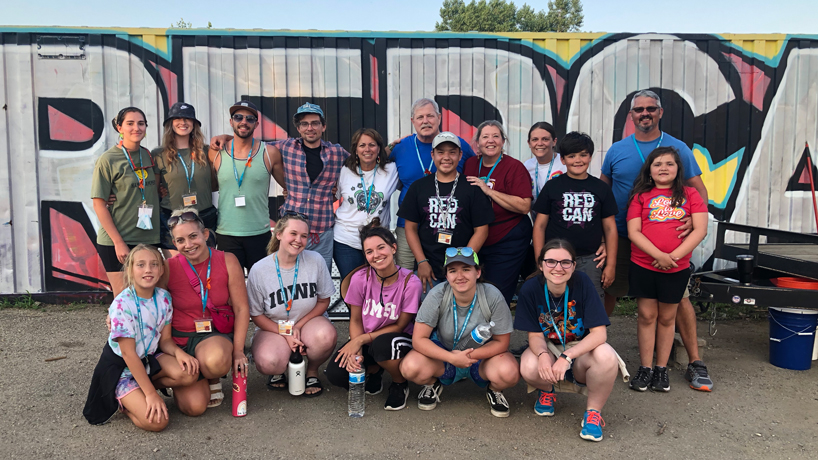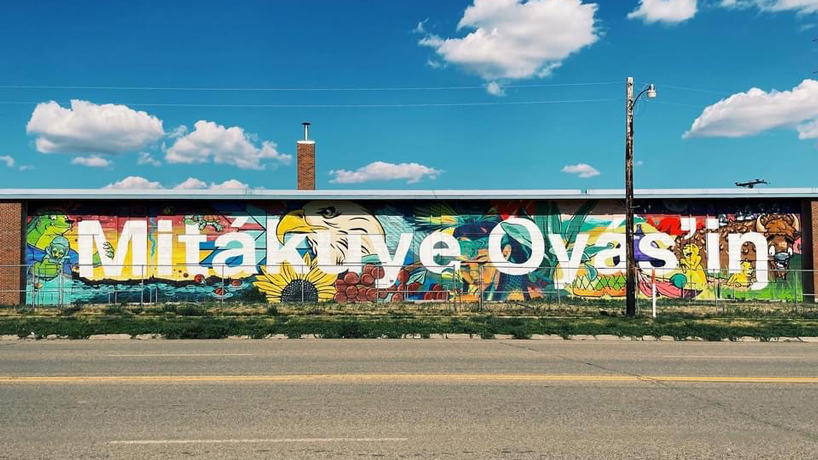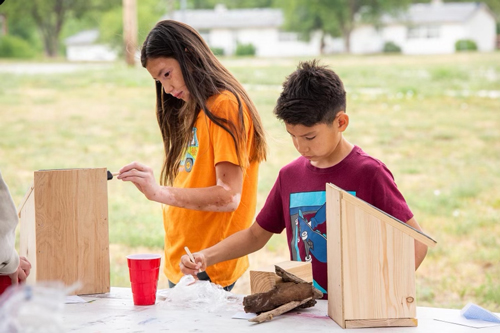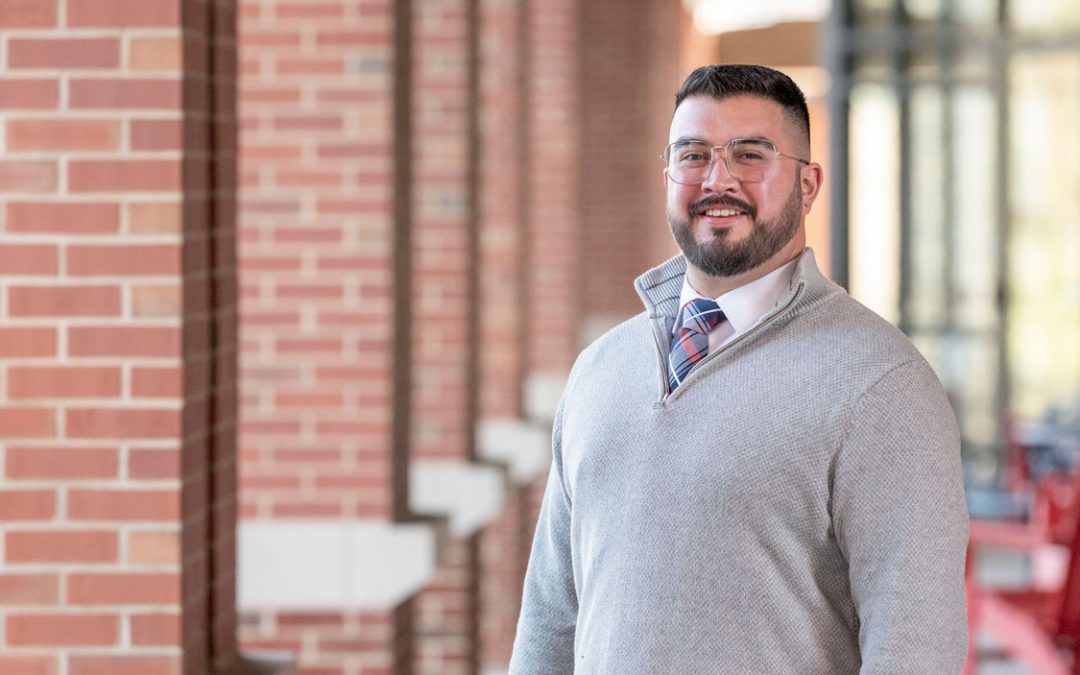
Dana Klar (back row, fifth from left), assistant teaching professor of child advocacy studies at UMSL, has brought faculty, staff and students to volunteer at Cheyenne River Youth Project’s annual RedCan Grafitti Jam for the past three years. This year, she brought five students, three alumni and five applied psychology in child advocacy studies faculty and staff members and family, including a few children. (Photos submitted by Dana Klar)
Two former Indian Health Services buildings sat neglected on the Cheyenne River Sioux Reservation in Eagle Butte, South Dakota for years.
They had become dilapidated – the exteriors in varying states of disrepair – until they found new life this summer during the Cheyenne River Youth Project’s annual RedCan Grafitti Jam. Over the course of four days, indigenous artists and community members transformed them.
The centerpiece is a wall-sized mural that reads, “Mitákuye Oyás’in.” The Lakota phrase means “all my relations” and reflects the world’s interconnectedness. It was accompanied by imagery including a buffalo, eagle and other symbols meaningful to the Lakota people with colors spanning the rainbow.
“That says for everybody who passes through the main street of this reservation to the tribal headquarters of this reservation that ‘we are all related,’” Dana Klar said. “It’s just gorgeous.”
The centerpiece mural of this year’s RedCan Grafitti Jam expresses a sense of interconnectedness with the Lakota phrase, “Mitákuye Oyás’in.”
Klar, an enrolled tribal member of the United Houma Nation and assistant teaching professor of child advocacy studies at the University of Missouri–St. Louis, was there to see the mural go up earlier this July. The Cheyenne River Sioux Reservation has become something of a second home for Klar who has journeyed there each summer since 2013 to volunteer with the Cheyenne River Youth Project (CRYP).
For the past three years, Klar, the UMSL team leader, has volunteered during RedCan with a variety of UMSL community members. This year, she brought five students, three alumni and five applied psychology in child advocacy studies faculty and staff members and family, including a few children, to volunteer from July 3-11, assisting artists, providing children’s programming and serving community meals.
“I did not know what to expect when I signed up for the trip,” said Emily Kersten, a senior psychology major who volunteered. “We came to the Cheyenne Sioux Reservation ready to work with the community and be there for whatever they needed during the week of the RedCan Graffiti Jam. We worked really hard providing meals and art activities for the children, and I’m incredibly proud of the UMSL team and all the work we accomplished.”
Financial and logistical support for the trip came from Thrivent, a Lutheran ministry, and the UMSL community. Thrivent provided two generous grants while UMSL faculty and staff members helped find transportation and contributed individual donations.
A student brought the CRYP to Klar’s attention around 2012 while she was teaching at Lindenwood University. The student had just returned from volunteering on the reservation with a St. Louis non-profit organization called Saints With A Mission Purpose-Indian Nations (SWAMP-IN) and also saw Klar’s passion for indigenous issues in the classroom.
Klar then contacted Debbie Wills, a SWAMP-IN leader who had been taking teams to CRYP for at least seven years, about getting involved with the CRYP. Wills happened to be hosting a young man from Cheyenne River Sioux Reservation at the time. One meeting was all it took to spark the now longstanding partnership.
“He wanted to come to St. Louis to give back because of the flooding,” Klar said of the visiting tribal member. “We had just been through a major flood, so he said, ‘You guys always come up to serve us. Now it’s my turn. There are some of us that want to come help you.’ I already felt a big connection, and I’m like, ‘Yeah I want to go.’”
For several years, Klar would take a team for a week at a time to work at the CRYP. They would do anything needed – housekeeping, cooking, gardening, yard work and leading kids’ activities – for the nonprofit youth project.
The CRYP was originally founded in 1988 by Julie Garreau to address the community’s needs for services to support struggling children and their families. The story of its founding and continued success is an inspiration to many, including Klar.
“She wanted something for kids to do after school, so she went to tribal council and asked them to give her a bar that shut down,” she said. “It was called the Old Brown Jug, I believe, and she said, ‘Just give me a building, and I will start after-school activities for youth.’”
The former bar became colloquially known as, “The Main,” because of its location on Main Street, and despite its modest means, the center was always packed with local children. The CRYP has continued to expand over the years, building two new youth centers and an art park. Klar has seen the growth firsthand, and children still flock to the new buildings nearly every day.
In 2015, the CRYP launched RedCan – an invitational graffiti festival where indigenous artists and visiting artists from around the world convene to spray paint murals throughout the community. The emphasis on graffiti as an art form and the graffiti subculture has given young Lakota people a creative voice and has also served as a way to strengthen their connections to Lakota culture and heritage.
Klar heard about RedCan on previous trips, but only started volunteering for it specifically three years ago when Garreau suggested UMSL would be a good fit for the event. She and her teams of UMSL volunteers have already left a mark on RedCan.
“The first time I was there, though, I was shocked because the kids kept showing up at the building that we stay in and there were no specific activities for them,” Klar said. “We asked the second year if we could add in some kids activities. That was 2019, and they really liked it. UMSL co-team leader, Dr. Jerry Dunn, has led in coordinating several art project offerings both years.”
Lakota children decorate bee houses made by students in the School District of University City. They were hung throughout the community to serve as “pollination stations.”
This summer, the UMSL team and volunteers from Ursuline College collaborated to create a whole slate of activities for kids. The programming included creating windchimes, necklaces and origami boxes, as well as a sidewalk chalk coloring event. UMSL volunteers also brought bee houses made by youth in the School District of University City for the kids to decorate and hang as “pollination stations.”
Photo artist trading cards were also provided to youth at both sites so they could meet their co-collaborator. This special project was funded by a Missouri Campus Compact mini-grant initiated by Klar and Dunn.
For a couple of lucky volunteers, the most thrilling parts of RedCan was getting front row seats to the creation of the murals.
“They grabbed two of our 14 adults to go be artist assistants, which is a really great position for the week,” Klar said. “They go out, and they’re just kind of there with the artists while they’re in the community. They’re trying to help interface with the community and explain the artwork. More of the artists are opening up a little bit, where they’re letting the artist assistants and youth in the community help paint. It’s just really fun for those who get to do that.”
Klar’s favorite moment was taking part in a special ceremony of this year’s RedCan, which included the groundbreaking of a new youth arts center and a memorial service for a young man who took his own life during the pandemic and whose name will adorn a part of the new building.
She and the other participants met and honored the young man’s family and then participated in a drum circle to begin healing and to bring attention to the need for mental health resources in the community.
“It was really special to us to be able to be there for that,” she said, “to be part of both the little bit of healing for those of us who had met the young man and to be a part of the memorial service but then to also move on to thinking about the future and the excitement for this latest youth programming at Cheyenne River Sioux Nation.”
















